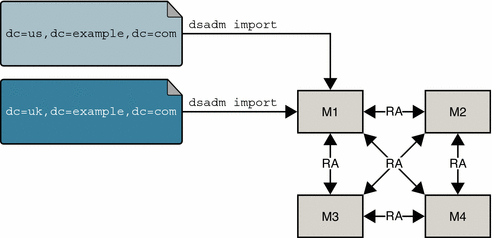Restoration From LDIF
Restoration from an LDIF file is performed at the suffix level. As such, this process takes longer than a binary restore. Restoration from LDIF can be performed using one of the following commands:
-
dsadm import must be run offline, that is, when the Directory Server instance is stopped. This command must be run on the local server containing the Directory Server instance.
-
dsconf import can be run online and remote to the Directory Server instance.
Restoration from an LDIF file has the following advantages:
-
This command can be performed on any server, regardless of its configuration.
-
A single LDIF file can be used to deploy an entire directory service, regardless of its replication topology. This functionality is particularly useful for the dynamic expansion and contraction of a directory service according to anticipated business needs.
Restoration from an LDIF file has one limitation. In situations where rapid restoration is required, this method might take too long to be viable. For more information about restoring data from an LDIF file, see Importing Data From an LDIF File in Sun Java System Directory Server Enterprise Edition 6.0 Administration Guide.
In the following figure, dsadmin import is performed for each replicated suffix, on one master only (M1).
Figure 8–5 Offline Restoration From LDIF

- © 2010, Oracle Corporation and/or its affiliates
